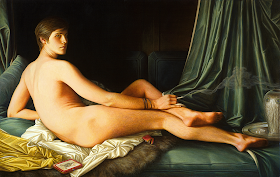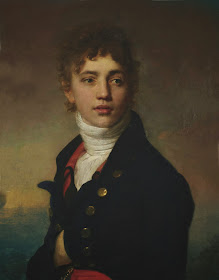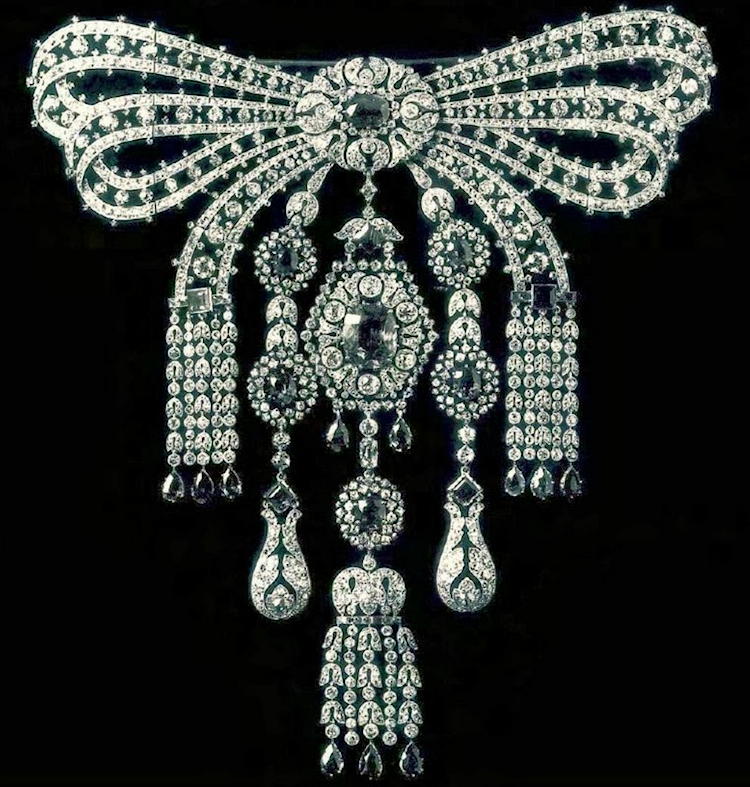Monday, September 30, 2013
Still lifes by Baron de Meyer
Sunday, September 29, 2013
Alexander Roslin - "Marie Emilie Boucher", 1779
A beautifully realized portrait. His execution of the white satin gown and pink satin ribbons is a master class in the rendering of that fabric. Flawless.
Saturday, September 28, 2013
A wedding exit
I know nothing about this photograph, but isn't this happy pair marvelous? His faultless tailoring and the wonderfully extravagant pretensions of her couturier have conspired with Nature - and the photographer - to create the most glamorously windswept post-nuptial descent.
Fearless color, compulsive detail - Frederick Sandys
Friday, September 27, 2013
Queen Hedwig's wedding dress
Hedwig Elisabeth Charlotte of Holstein-Gottorp (22 March 1759 – 20 June 1818), Queen of Sweden and Norway. Married in 1774 at the age of fifteen to the future King Charles XIII and II.
 |
| The future queen Hedwig in her wedding gown, 1774, portrait by Alexander Roslin. |
 |
| The original gown; the engageants and other lace trim have been removed. |
 |
| Cloth of silver, silver embroidery, silver lace. |
Arkhip Kuindzhi - the greenest green....
A selection of paintings by the Russian landscape artist Arkhip Ivanovich Kuindzhi, (January 27, 1842(?) – July 24, 1910)
Thursday, September 26, 2013
Jérôme-Martin Langlois (Paris, March 11, 1779 - Paris, December 28, 1838), "Portrait of the Comte de M.", 1831
One of my favorite paintings at the Portland Art Museum. The subject has such character; his smiling eyes and the way his lower lip tucks in under the upper is so charming, touching somehow. And he looks ready to speak to the viewer - the voice would be basso, certainly, with a rumbling, rolling French.
Pauline Astor by John Singer Sargent, 1898
And the Dog? Sargent's portraits are usually so seriously glamorous; there isn't much humor to be found in his work. But then there's this charming little Spaniel, and the bright gaze and tight chin of its mistress, who looks to be stifling a laugh.
Wednesday, September 25, 2013
Stealing Ideas From Ingres, or: The Harem, Redecorated
I didn't want to reproduce the original Orientalist details, so I came up with a vaguely Fin de siècle decor; Fabergé-style enameled cigarette case and matchbox, Art Nouveau silver and enamel vase. And since my friend was quite the smoker, I used that to my advantage, replacing the original's waft of incense with the more pedestrian trail of drifting cigarette smoke. Oh, and the cigarette butts....
 |
| Le Fumeur - After Ingres - acrylic on panel - 14x22 - 2002-11 |
Personnes royales, en privées....
Tuesday, September 24, 2013
Maria Isabel de Bragança, Infanta of Portugal, Queen of Spain - by Vicente López y Portaña, circa 1816-18
Maria Isabel Francisca de Bragança (19 May 1797 – 26 December 1818), Infanta of Portugal, Queen of Spain as the second wife of Ferdinand VII. She was the major force behind the founding of what came to be the Museo del Prado. She died, horrifically, in childbirth at the age of twenty-one, a year before the museum opened to the public.
Monday, September 23, 2013
Sunday, September 22, 2013
Sapphires and emeralds - new and "previously owned" merchandise
As for the "more famous emeralds", these were also given to her by her aunt. A tiara and necklace, and perhaps other pieces that I haven't seen documented. The central section of the necklace could be detached and worn as a brooch, as it most often was. I've only ever seen one photograph of the Grand Duchess Elisaveta wearing the tiara - and that taken at a distance - but like most large and "important" jewels, sections could be detached and used in other ways. The large diamond-ringed cabochon emeralds from the tiara are visible as "buttons" down the front of her court gown in the first image below, and as ornamentation for her traditional kokoshnik in the second two.
After escaping revolutionary Russia, Maria Pavlovna found refuge in Roumania, where her flamboyant first cousin, Marie, was queen. In the depths of World War I, Queen Marie had sent her jewelry to her ally Russia for safekeeping. An unwise decision as it turned out; before the war was even over, the revolution in Russia had broken out, and the victorious Bolsheviks were not at all inclined to return her jewels. Having three daughters approaching a marriageable age, and with an outsized love of adornment, herself, she set about buying up a large portion of the jewelry that her near relatives, newly exiled, were so eager to sell. Queen Marie purchased the tiara and necklace to give to her daughter who was soon to marry King Alexander of Yugoslavia; "Mignon", as she was called in the family, wore the necklace pinned to the neckline of her gown on her wedding day. (I should mention that I've also read that it was the King, himself, who bought the emeralds for his bride. I'm not certain which story is accurate.)
Subsequently, the necklace was broken up and the stones reused to create a heavy sautoir by Cartier.
Both necklace and tiara were later sold. I don't know the fate of the necklace, but the tiara still exists in the collection of Van Cleef & Arpels. The emeralds have been replaced with paste copies.








_-_May_Margaret,_1865-6.jpg)






















,+Le+Cabinet+de+travail+du+roi+Louis-Philippe+%C3%A0+Neuilly,+1845.jpg)















_Bergamasco_-_Elisabeth_Fiodorovna_de_Russie_(Elisabeth_de_Hesse_Darmstadt)_(1864-1918)_-_Port_-_(MeisterDrucke-1411380).png)


.png)






